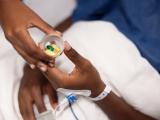Two new reports on antibiotics prescribing and spending are adding to the evidence that campaigns to improve antimicrobial stewardship in the United States are beginning to pay off.
One report, from Blue Cross Blue Shield (BCBS), says that the overall number of antibiotic prescriptions filled by US patients with commercial medical insurance dropped 9% between 2010 and 2016. The decline for broad-spectrum antibiotics, the kind most likely to promote bacterial resistance, was even greater at 13%.
In the other report, published today in Clinical Infectious Diseases, researchers found that overall US spending on antibiotics dropped 16.6% between 2010 and 2015. With inflation factored in, the decrease came to 22.6%.
BCBS data drawn from 31 million patients
The BCBS study used the insurance group's claims database to count antibiotic prescriptions filled by commercially insured members (patients) as the result of outpatient visits from 2010 through 2016. The study included 173 million claims for filled prescriptions from more than 31 million people younger than 65.
Overall, the number of filled prescriptions per 100 members dropped 9% over the 7 years, from 90.7 in 2010 to 82.6 in 2016, the report says. The 13% drop for broad-spectrum antibiotics, from 50.2 to 43.7 prescriptions per 100 members, was the steepest decline among the four categories of drugs examined.
Much smaller decreases were seen for two other categories of antibiotics: intermediate-spectrum, 5%, and narrow-spectrum, 3%. The "fill rate" for the fourth category, reserved antibiotics, went the other direction, rising 30%, but it remained very low at 0.5 prescriptions per 100 members. The report defines reserved antibiotics as narrow-spectrum drugs used for bacteria that have developed resistance to other antibiotics.
"This reserved antibiotic fill rate increase may be from higher rates of infection from bacteria with resistance to broader-spectrum antibiotics," the report states. "The change could also reflect a shift from inpatient to outpatient use of reserved antibiotics in recent years."
Biggest Improvement seen in children
By age-group, the drop in fill rate was substantially greater for children (under age 18) than for adults: 16% versus 6%. And for infants up to a year old, the decline was 22%, according to BCBS. Fill-rate decreases were similar for women (8%) and men (9%).
BCBS researchers also found wide variations in the prescriptions filled by state and region. The three states with the highest rates—Mississippi, Alabama, and Arkansas—had numbers nearly three times as high as the three states on the other end of the spectrum—Hawaii, Oregon, and Montana. Some Appalachian states, such as Kentucky, West Virginia, and Tennessee also had high rates, while states with the lowest rates clustered in New England and the West.
The report also exposed a rural-urban divide, with 16% more prescriptions filled in rural than in urban counties (in 2016, 92.7 prescriptions per 100 members in rural counties, versus 79.9 in urban counties).
Prescription counts also differed by outpatient setting: office visits, emergency departments, retail health clinics, and online visits. Broad-spectrum drugs were prescribed less often in retail health clinics than in the other three settings (49% of all antibiotic prescriptions were for that category, versus 58% to 60% in the other settings).
Regarding other issues surrounding prescribing, BCBS found that the share of antibiotic prescriptions considered inappropriate continued to be relatively high. In 2016, the proportion of antibiotic prescriptions for "not indicated" conditions was 21%, while 63% of prescriptions were for "maybe indicated" conditions, the report says. The 21% figure is somewhat lower than an oft-quoted estimate that about 30% of all antibiotic prescriptions written for outpatients are inappropriate.
"Public health efforts to increase the awareness of excessive antibiotic use and the threat posed by antibiotic-resistant bacteria appear to be achieving measurable results," the report states, adding that there is still plenty of room for improvement.
Less spending on antibiotics
The report on antibiotics spending was prepared by a team of researchers from the University of Illinois at Chicago, the US Department of Veterans Affairs, the Centers for Disease Control and Prevention, and QuintilesIMS, a private company that maintains a database on medication spending by healthcare organizations and public services in the United States.
The team used the database to gather information on spending for systemic antibiotics from January 2010 to December 2015. The data include spending by community and mail-order pharmacies, non-federal hospitals, "other non-retail" settings (such as nursing homes), and outpatient clinics. For pharmacies, the researchers looked at what the businesses themselves spent on antibiotics, not at what patients and insurers paid. And for clinics, the team focused on what the settings paid for antibiotics that providers administered, such as intravenous drugs and directly observed therapy (DOT).
The tam found that spending on antibiotics over the 6-year period totaled $56 billion, 59.1% of which was associated with outpatient settings. Overall spending in 2015 was $8.8 billion, down 16.6% from the $10.6 billion spent in 2010. When adjusted for inflation to 2015, the decrease rose to 22.8%. The only year that showed an increase in overall spending was 2013, at 8.6%.
Big drop in pharmacy spending
In community pharmacies, antibiotics expenditures dropped 37.4% over the 6 years, while spending in non-federal hospitals declined 13.7%, the researchers said. But the amounts spent in other settings rose: 67.0% for mail-order pharmacies, 9.6% for other non-retail settings, and 148% for clinics. Mail-order pharmacies and clinics accounted for relatively small shares of the overall expenditures.
Commenting on the big decrease on spending in community pharmacies, the authors said, "While the decreases in overall antibiotic prescribing [reported in other studies] are not on par with the decreasing expenditures, and cannot be directly linked to one another, our results may be an early indicator that national stewardship initiatives are improving outpatient antibiotic prescribing."
As for the increased spending by mail-order pharmacies and clinics, the authors said they are in line with increases in overall drug spending. The clinic figures, they added, may represent increased use of outpatient parenteral antimicrobial therapy (OPAT), often used in patients after hospital discharge. Studies have suggested that 34% to 41% of OPAT courses are inappropriate, they observed, adding, "There are likely opportunities to implement antibiotic stewardship interventions at the time of hospital discharge focused on OPAT."
The team also looked at the spending trends for particular classes of antibiotics. Quinolones had the biggest drop, at 91%, but this was probably because levofloxacin and moxifloxacin lost their US patents in 2011, leading to the availability of cheaper generic versions, the report says. Spending on tetracyclines increased, but this was mainly related to manufacturing problems that limited the supply of doxycycline in 2013.
See also:
BCBS report
Aug 25 Clin Infect Dis abstract























